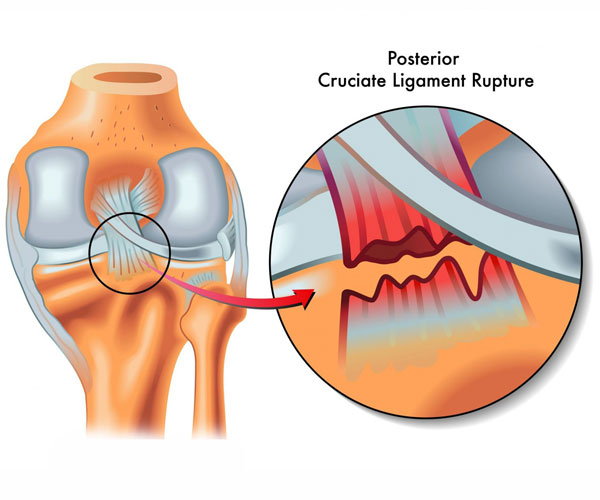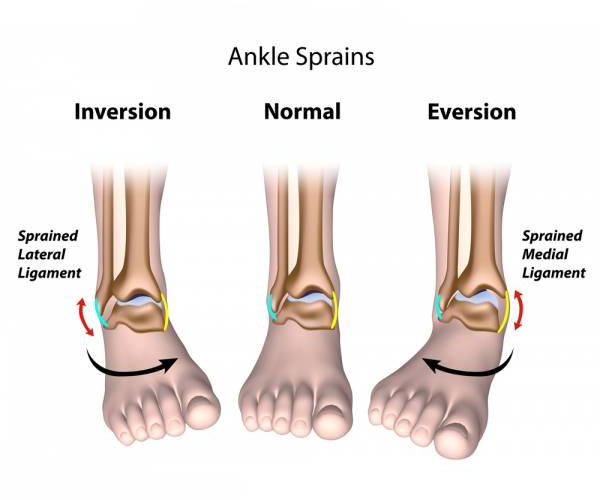Exercising is good for you, but sometimes you can injure yourself when you play sports or exercise. Accidents, poor training practices, or improper gear can cause them. Some people get hurt because they are not in shape. Not warming up or stretching enough can also lead to injuries. There are two kinds of sports injuries:
- Acute injuries occur suddenly when playing or exercising. For example:
- Sprained ankles.
- Strained backs.
- Broken bones.
- Chronic injuries happen after you play a sport or exercise for a long time.
Below are most common types of sports injuries
Runner's Knee:
 Runner's knee is the most common type of sports injury. The problem happens most commonly to runners, cyclists, swimmers, as well as people who practice aerobics, play football, basketball and volleyball. Overuse of the knee leads to irritation of the tendon below the knee-cap which results in this problem.
Runner's knee is the most common type of sports injury. The problem happens most commonly to runners, cyclists, swimmers, as well as people who practice aerobics, play football, basketball and volleyball. Overuse of the knee leads to irritation of the tendon below the knee-cap which results in this problem.
Knee Ligament Injuries (ACL Tear/MCL Tear/PCL Tear/Meniscus Tear)
 Knee injuries can be the result of getting hit on the knee, falling down, or landing on a flexed knee. These are most common to footballers. These typically involve the ligaments that hold two of the bones of the knee – the anterior cruciate ligament (ACL), the medial cruciate ligament (MCL), or the posterior cruciate ligament (PCL).
Knee injuries can be the result of getting hit on the knee, falling down, or landing on a flexed knee. These are most common to footballers. These typically involve the ligaments that hold two of the bones of the knee – the anterior cruciate ligament (ACL), the medial cruciate ligament (MCL), or the posterior cruciate ligament (PCL).
Shoulder Injury (Rotator Cuff Tear)
 These injuries occur mostly during tennis, swimming, and voleyball. The chief cause of these problems is the overuse of the shoulder, which loosens the rotator cuff (a group of tendons and muscles around the shoulder).
These injuries occur mostly during tennis, swimming, and voleyball. The chief cause of these problems is the overuse of the shoulder, which loosens the rotator cuff (a group of tendons and muscles around the shoulder).
Ankle Sprain
 Ankle sprains are common to any activity that involves jumping, running or turning quickly (e.g., playing football, basketball etc). Such motion can lead to twisting of the ankle and possible tearing of a tendon/ligament.
Ankle sprains are common to any activity that involves jumping, running or turning quickly (e.g., playing football, basketball etc). Such motion can lead to twisting of the ankle and possible tearing of a tendon/ligament.
Tennis/Golfer’s Elbow
 Tennis Elbow involves tendon degeneration in the elbow due to repeated backhand strokes common to tennis. This condition leads to oain on the outside of the elbow. Golfers Elbow impacts the inside of the elbow, due to the inflmaation of the muscles responsible for forearm-flexing.
Tennis Elbow involves tendon degeneration in the elbow due to repeated backhand strokes common to tennis. This condition leads to oain on the outside of the elbow. Golfers Elbow impacts the inside of the elbow, due to the inflmaation of the muscles responsible for forearm-flexing.
Shin Splints
 Shin Splints refers to pain on the inside of shinbone caused by inflammation of the surrounding muscles. These occur mostly in cases of inactive people. who start working out and increase their intensity too fast.
Shin Splints refers to pain on the inside of shinbone caused by inflammation of the surrounding muscles. These occur mostly in cases of inactive people. who start working out and increase their intensity too fast.
Groin Strain
 This refers to a strain the adductor muscles, situated in the upper thigh which help to pull the legs together and causes sharp pain and swelling on the inside of the thigh. This usually happens when one changes directions suddenly while running.
This refers to a strain the adductor muscles, situated in the upper thigh which help to pull the legs together and causes sharp pain and swelling on the inside of the thigh. This usually happens when one changes directions suddenly while running.
Hamstring Strain
 The hamstrings are the muscles behind your thighs. Hamstring strains most commonly occur due to inadequate warming up or excessive fatigue.
The hamstrings are the muscles behind your thighs. Hamstring strains most commonly occur due to inadequate warming up or excessive fatigue.
Prevention of Sports Injuries
- One of the easiest, yet most important prevention techniques for sport injuries is to choose the correct shoes and insoles, and keep replacing them regularly as they get worn out.
- Running on a softer surface like an indoor track rather than the road or pavement can also prevent a number of injuries.
- To prevent shoulder injuries, it is most important to strengthen your muscles through weight training before getting involved in active sports.
- Always stretch properly before and after exercise, and do not work out when you are weak or fatigued.
- Never resume your sports activities until your injury is fully healed. Restarting activity too soon can lead to chronic issues.
Treatment of Sports Injuries
Medicines/Pharmacotherapy - One of the easiest techniques for pain control is using conservative care (e.g., resting the impacted part, using hot/cold packs) along with medicines, such as nonsteroidal anti-inflammatory drugs (NSAIDs) and adding a neuropathic agent in case of chronification of pain.
Braces - Depending on the site of injury, different braces (e.g., thigh brace, elbow brace, arch brace, wrist brace, ankle brace, or knee brace) can be used to restrict the motion of the impacted part, control pain and speed up the recovery process.
Injections - Intralesional injections in the impacted part can provide significant pain relief in cases where medicines haven’t worked. Such interventional techniques should be followed by regular stretching and exercises for better results.
Platelet Rich Plasma (PRP) Therapy - PRP therapy involves injecting platelets from the patient’s own blood to rebuild a damaged tendon or cartilage. It has been successful in not only relieving the pain, but also in jumpstarting the healing process. The patient’s blood is drawn and placed in a centrifuge for 15 minutes to separate out the platelets. The platelet-rich plasma is then injected into the damaged portion of the tendon or cartilage.

 Runner's knee is the most common type of sports injury. The problem happens most commonly to runners, cyclists, swimmers, as well as people who practice aerobics, play football, basketball and volleyball. Overuse of the knee leads to irritation of the tendon below the knee-cap which results in this problem.
Runner's knee is the most common type of sports injury. The problem happens most commonly to runners, cyclists, swimmers, as well as people who practice aerobics, play football, basketball and volleyball. Overuse of the knee leads to irritation of the tendon below the knee-cap which results in this problem. Knee injuries can be the result of getting hit on the knee, falling down, or landing on a flexed knee. These are most common to footballers. These typically involve the ligaments that hold two of the bones of the knee – the anterior cruciate ligament (ACL), the medial cruciate ligament (MCL), or the posterior cruciate ligament (PCL).
Knee injuries can be the result of getting hit on the knee, falling down, or landing on a flexed knee. These are most common to footballers. These typically involve the ligaments that hold two of the bones of the knee – the anterior cruciate ligament (ACL), the medial cruciate ligament (MCL), or the posterior cruciate ligament (PCL). These injuries occur mostly during tennis, swimming, and voleyball. The chief cause of these problems is the overuse of the shoulder, which loosens the rotator cuff (a group of tendons and muscles around the shoulder).
These injuries occur mostly during tennis, swimming, and voleyball. The chief cause of these problems is the overuse of the shoulder, which loosens the rotator cuff (a group of tendons and muscles around the shoulder). Ankle sprains are common to any activity that involves jumping, running or turning quickly (e.g., playing football, basketball etc). Such motion can lead to twisting of the ankle and possible tearing of a tendon/ligament.
Ankle sprains are common to any activity that involves jumping, running or turning quickly (e.g., playing football, basketball etc). Such motion can lead to twisting of the ankle and possible tearing of a tendon/ligament. Tennis Elbow involves tendon degeneration in the elbow due to repeated backhand strokes common to tennis. This condition leads to oain on the outside of the elbow. Golfers Elbow impacts the inside of the elbow, due to the inflmaation of the muscles responsible for forearm-flexing.
Tennis Elbow involves tendon degeneration in the elbow due to repeated backhand strokes common to tennis. This condition leads to oain on the outside of the elbow. Golfers Elbow impacts the inside of the elbow, due to the inflmaation of the muscles responsible for forearm-flexing. Shin Splints refers to pain on the inside of shinbone caused by inflammation of the surrounding muscles. These occur mostly in cases of inactive people. who start working out and increase their intensity too fast.
Shin Splints refers to pain on the inside of shinbone caused by inflammation of the surrounding muscles. These occur mostly in cases of inactive people. who start working out and increase their intensity too fast. This refers to a strain the adductor muscles, situated in the upper thigh which help to pull the legs together and causes sharp pain and swelling on the inside of the thigh. This usually happens when one changes directions suddenly while running.
This refers to a strain the adductor muscles, situated in the upper thigh which help to pull the legs together and causes sharp pain and swelling on the inside of the thigh. This usually happens when one changes directions suddenly while running. The hamstrings are the muscles behind your thighs. Hamstring strains most commonly occur due to inadequate warming up or excessive fatigue.
The hamstrings are the muscles behind your thighs. Hamstring strains most commonly occur due to inadequate warming up or excessive fatigue.